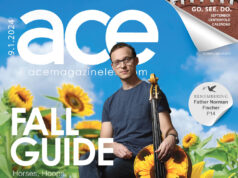View PDF “Talking About Tread. Blurfect hits Stands” p 6 ACE Weekly March 11, 2010 03.10.2010
This Week’s guest Ace Cover Artist, Photographer, and Cover Designer (subbing in for designer Clif Dickens) is Larry Joe Treadway, better known as Tread, with two new limited edition books Blurfect and Game Day. Game Day is a super-limited edition handmade artist’s book that documents a day at the cathedral of basketball— Rupp Arena—as 24,000 fans showed up for ESPN’s “Game Day” program.
At gotreadgo.com, Tread hosts his photoblog. Collectors can contact him about prints there. Lookers and readers can go too, and comment and follow his links to the work of his colleagues around the world. Blurfect, features indeed 36 of Tread’s canonical toy camera images. But it also features 36 Tread koans: “As a kid, was there any greater freedom than that damned orange bike? I miss that kind of free.” blurfect.com
Tread has been an Ace contributing photographer and writer (Brains on Film) since 1989, and a frequent story subject (Ted Bundy’s Volkswagen).
What you’re looking at when you’re looking at Tread
We ask musicians about their influences and then probe aural corners to see if we were right. These are some great photographers who fly around the edges of Tread’s work.
Edward Weston: (1886-1958) A Highland Park, Ill. native
who worked in California near Big Sur for most of his life, taking photographs. Founder of f/64. Known for work with
still lifes (his peppers series) nudes, landscape and depth of
field. (edward-weston.com)
William Eggleston: (1939-) Memphis native, credited with introducing color to art photography in his Museum of Modern Art show in 1976 and
for finding beauty in ordinary scenes in the South. Eggleston himself was influenced by Robert Frank and Henri Cartier-Bresson and is known for his “democratic camera” approach. His “The Red Ceiling” (1973) is his most famous work, and was used as album cover art on the Big Star “Radio City” record. (egglestontrust.com)
Ralph Eugene Meatyard: (1925-1972)
Worked here in Lexington, where he was a one-time optician at Tinder-Krauss-Tinder and a founder of the Lexington Camera Club. Now acknowledged as one of the great photographers, worked in relative isolation here in Kentucky, developing a “No Focus” imagery style and portraying unsettling questions visually. Family members, dolls and masks are some of the trademarks of his imagery.
David Grubbs, the Louisville musician behind has a tune called “Eyeglasses of Kentucky” that is a tribute to Meatyard on his current record. (masters-of-photography.com)
Larry Fink: (1941-) Originally from Brooklyn, Fink is also influenced by Cartier-Bresson. His one-man shows at the Whitney, Museum of Modern Art and his commercial work for clients like Smirnoff, Vanity Fair and the New York Times Magazine, show the focus on the moment and intimacy of gesture. (larryfinkphotography.com)
Robert Mapplethorpe: (1946-1989) Originally from Floral Park, N.Y., Mapplethorpe worked with a Hasselblad medium format camera, shooting floral still life, portraits of celebrities like Grace Jones and Andy Warhol, and nude studies, which included homoerotic scenes. The Patti Smith “Horses” album cover portrait is by Mapplethorpe, who was central in the NYC 1970s punk scene. Near the end of his life, controversy over the subject matter of some of his works became a national debate over the funding of art, with “The Perfect Moment” show in Cincinnati as one point of contention. (mapplethorpe.org).
TALKING TREAD
We asked around about Tread. Here is what some leading photographers and photo editors said:
Tread’s photography combines a touch of the ordinary with a surreal pinch of gothic South narrative imagery as seen through a crappy plastic lens. Throw in a little bit of Meatyard — his photographic mentor and local hero — with a fistful of rock and roll and you come out with an unforgettable pastiche of soulful, witty images filled with Southern charm and humor.
Bill Vaccaro Fine Art Photographer
Chicago http://billvaccaro.visualserver.com/
The nice thing about Tread – a guy I have never actually met – is that he seems to have a bit of twisted genius to him. His imagery has a kinetic maybe I should try that quality of someone who probably makes images easily, with a seeming punk rock lack of concern with perfection. And he then puts words together that bring a rhythmic bourbon and onion smack you with them. Photo tribes tend to repeat themselves endlessly and so the people that propel any group forward are fewer and further between and probably will come from without as often as not. Tread seems to fit the scout or outlander mold, the guy that just might bring the knowledge of ice to the glandlocked photo villagers. The combination of words and images may or may not always work but the combination will definitely leave an impression and I have the sense that, like most psycho-hobo wayfarers, Tread will have already moved on to something else, more or less unconcerned by the various critiques and interpretations of those in his wake. Gordon Stettinius www.eyecaramba.com Richmond, Virginia
When I first saw his work i was very much taken by it. I work as photo editor for Vice magazine and I have this website for talented photographers, so I see many pics every day. I am generally not too much into Holga photography, because I think that few people really know how to create a very interesting image, whilst many just find it interesting for the random “strange” pictures they take. Well, Tread is definitely one who knows what to do with it.
Lele Saveri, (has used Tread images in a couple of shows around Europe, some publications) ithoughtiwasalone.com Milan, Italy
Tread exploits toy cameras of all kinds with stunning results. The endearing characteristics of these less than perfect cameras don’t define his images. Instead they inform and accentuate the unrefined process of becoming a man. Light leaks, blur, aberrations and frayed edges all work together, illustrating the imperfections
of change and memory. When I first got involved with the online toy camera community, I immediately gravitated towards Tread’s style and content. The hallmarks of growing from boy to man are captured and studied, reminding us of those joys and fears but without affectations. He not only tells these stories photographically and verbally but reaches a little deeper, urging me to be a better father, a better man.
Warren Harold Photographer Houston, Texas www.thatwasmyfoot.com
TREAD — Selected awards
• “Best of Show B/W”
PhotoMedia Center “Holga 3.0”
• “Juror’s Award”
Photography – What Now?
• Winner
Al Smith Professional Award
Kentucky Arts Council
• Winner
World Toy Camera Day 2004, 2005, 2006, 2007
• Winner, Best Writing 2006
• Winner,Best Writing 2007
• Nominee, Best Toy Camera Photography
• Nominee Photoblog of The Year
Photobloggie Awards ■
TREAD — Selected shows
• PhotoMedia Center “Holga 3.0” Pittsburgh
• “Toy Joy” Houston’s FotoFest Houston
• “The Art of Photography” Lyceum Gallery, San Diego
• “Toy Polloy – An International Showing” The Icehouse, Lexington
• “We Are All Photographers Now” Musée de L’Elysée, Lausanne Museum for Photography Switzerland
• Soho Photo New York
Toy, blur, filmwasting backstory
In January 2010, in Los Angeles – a city that could be said to know its way around an image and photographic technology— the “Best in Show” at Photo LA 2010 was awarded to a blurred black and white grouping shot
with a plastic camera held together with black tape.
Susan Burnstine is one of the original “Filmwasters,”
one name adopted by a group of art photographers who
also are hailed by terms such as “lo-fi,” “toy camera,”
“plastic,” and “analog.”
The group shoots with cheap plastic, toy cameras
named Holga, Diana, Lomo or with retrofitted Polaroids or, as with Burnstine, cameras of
their own design.
One leader in the group, Warren Harold, produces beautiful art with a pinhole camera made
of a diaper box.
And, they work with film. In an era of nearly infinite digital possibility for manipulations unto
perfection, they embrace, with as few interventions as possible, photography’s original infinities:
the light and the moment. And it is perfect.
The cameras by nature, “leak light” and create distinctive “vignetting” and “blur.” The creation
of art with them strips nearly every technology away. The light, the moment, the eye.
Communing on Web sites like filmwasters.org, toycamera.org, and flickr.com since about 2004, the
group, which includes resident agent provocateur Tread, holds a World Toy Camera Day event, started
out with shows like “Krappy Kamera” at Soho Photo and has grown to be part of (and the Best in )
shows like LA Photo 2010 and other major gallery exhibitions.
Now these “film” and “toy camera” and “Polaroid” effects are available as part of digital
iPhone photo applications and image processing software packages. You can buy a white snakeskin
motif Holga to go with your skinny jeans.
That will probably not stop these shooters with their 4-setting, taped, musty plastic cameras
and their refrigerated film stashes.
Infinite light means there’s enough for everyone.




